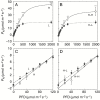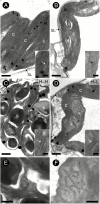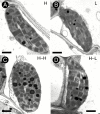Structural and photosynthetic re-acclimation to low light in C4 maize leaves that developed under high light
- PMID: 31127287
- PMCID: PMC6798838
- DOI: 10.1093/aob/mcz092
Structural and photosynthetic re-acclimation to low light in C4 maize leaves that developed under high light
Abstract
Background and aims: C4 plants have higher photosynthetic capacity than C3 plants, but this advantage comes at an energetic cost that is problematic under low light. In the crop canopy, lower leaves first develop under high light but later experience low light because of mutual shading. To explore the re-acclimation of C4 leaves to low light, we investigated the structural and physiological changes of the leaves of maize plants grown in shaded pots.
Methods: Plants were first grown under high light, and then some of them were shaded (20 % of sunlight) for 3 weeks. Four types of leaves were examined: new leaves that developed under low light during shading (L), new leaves that developed under high light (H), mature leaves that developed under high light before shading and were then subjected to low light (H-L) and mature leaves that always experienced high light (H-H).
Key results: The leaf mass per area, nitrogen and chlorophyll contents per unit leaf area, chlorophyll a/b ratio and activities of C3 and C4 photosynthetic enzymes were lower in H-L than in H-H leaves and in L than in H leaves. Unlike L leaves, H-L leaves maintained the thickness and framework of the Kranz anatomy of H leaves, but chloroplast contents in H-L leaves were reduced. This reduction of chloroplast contents was achieved mainly by reducing the size of chloroplasts. Although grana of mesophyll chloroplasts were more developed in L leaves than in H leaves, there were no differences between H-L and H-H leaves. The light curves of photosynthesis in H-L and L leaves were very similar and showed traits of shade leaves.
Conclusions: Mature maize leaves that developed under high light re-acclimate to low-light environments by adjusting their biochemical traits and chloroplast contents to resemble shade leaves but maintain the anatomical framework of sun leaves.
Keywords: C4 plant; chloroplast; leaf structure; light re-acclimation; maize; photosynthetic traits; shade leaf; sun leaf.
© The Author(s) 2019. Published by Oxford University Press on behalf of the Annals of Botany Company. All rights reserved. For permissions, please e-mail: journals.permissions@oup.com.
Figures





Similar articles
-
Photosynthetic acclimation during low-light-induced leaf senescence in post-anthesis maize plants.Photosynth Res. 2021 Dec;150(1-3):313-326. doi: 10.1007/s11120-021-00851-1. Epub 2021 Jun 4. Photosynth Res. 2021. PMID: 34086146
-
Effects of acclimation to long-term shading on photosynthesis in grapevines: roles of non-structural carbohydrates and stomatal conductance.Physiol Plant. 2024 Nov-Dec;176(6):e14636. doi: 10.1111/ppl.14636. Physiol Plant. 2024. PMID: 39604291
-
Systemic regulation of leaf anatomical structure, photosynthetic performance, and high-light tolerance in sorghum.Plant Physiol. 2011 Mar;155(3):1416-24. doi: 10.1104/pp.111.172213. Epub 2011 Jan 18. Plant Physiol. 2011. PMID: 21245193 Free PMC article.
-
Photosynthesis and resource distribution through plant canopies.Plant Cell Environ. 2007 Sep;30(9):1052-71. doi: 10.1111/j.1365-3040.2007.01683.x. Plant Cell Environ. 2007. PMID: 17661747 Review.
-
A worldwide analysis of within-canopy variations in leaf structural, chemical and physiological traits across plant functional types.New Phytol. 2015 Feb;205(3):973-993. doi: 10.1111/nph.13096. Epub 2014 Oct 16. New Phytol. 2015. PMID: 25318596 Free PMC article. Review.
Cited by
-
Light, Not Age, Underlies the Maladaptation of Maize and Miscanthus Photosynthesis to Self-Shading.Front Plant Sci. 2020 Jun 24;11:783. doi: 10.3389/fpls.2020.00783. eCollection 2020. Front Plant Sci. 2020. PMID: 32733493 Free PMC article.
-
Physiological and Transcriptome Responses of Sweet Potato [Ipomoea batatas (L.) Lam] to Weak-Light Stress.Plants (Basel). 2024 Aug 9;13(16):2214. doi: 10.3390/plants13162214. Plants (Basel). 2024. PMID: 39204650 Free PMC article.
-
Shading Stress at Different Grain Filling Stages Affects Dry Matter and Nitrogen Accumulation and Remobilization in Fresh Waxy Maize.Plants (Basel). 2023 Apr 23;12(9):1742. doi: 10.3390/plants12091742. Plants (Basel). 2023. PMID: 37176801 Free PMC article.
-
Cell wall thickness spectrum of photosynthetic cells in herbaceous C3, C4, and crassulacean acid metabolism plants.J Plant Res. 2025 Mar;138(2):197-213. doi: 10.1007/s10265-024-01603-7. Epub 2024 Dec 10. J Plant Res. 2025. PMID: 39658745
References
-
- Anderson JM, Chow WS, Rivas JDL. 2008. Dynamic flexibility in the structure and function of photosystem II in higher plant thylakoid membranes: the grana enigma. Photosynthesis Research 98: 575–587. - PubMed
-
- Bellasio C, Griffiths H. 2014a Acclimation to low light by C4 maize: implications for bundle sheath leakiness. Plant, Cell & Environment 37: 1046–1058. - PubMed
-
- Björkman O. 1981. Responses to different quantum flux densities. In: Lange OL, Nobel PS, Osmond CB, Zeigler H, eds. Encyclopedia of plant physiology, New Series, 12A. Dordrecht: Springer, 57–107.
Publication types
MeSH terms
Substances
LinkOut - more resources
Full Text Sources
Miscellaneous

